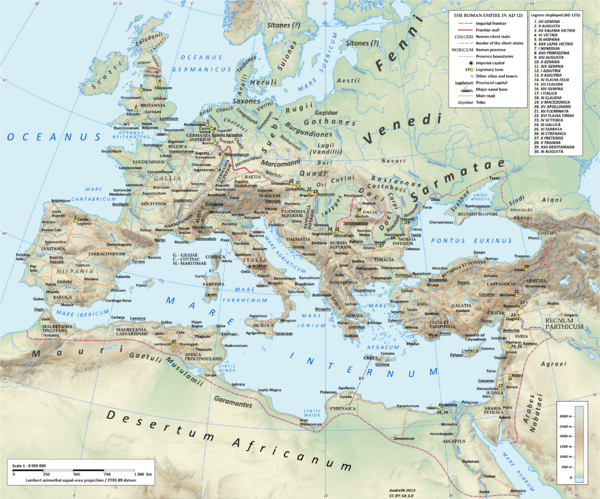History of Iranian peoples in Europe
| Part of a series on |
| Indo-European topics |
|---|
|
|
Origins |
|
Archaeology Pontic Steppe East-Asia Eastern Europe Northern Europe Pontic Steppe Northern/Eastern Steppe Europe South-Asia Steppe Europe Caucasus India |
|
Peoples and societies Indo-Aryans Iranians Europe East-Asia Europe Indo-Aryan Iranian |
|
Religion and mythology
Indian Iranian Other Europe |

The history of Iranian peoples in Europe stretches back as far as 750 BC, when a Proto-Scythian culture thrived in Eastern Europe (mostly modern-day Ukraine and Russia). "Iranian peoples" is a collective term comprising several ethnic groups whose common origin stems from the Proto-Iranians of Central Asia, and having little to do with the modern state Iran, much as "Germanic" is not directly related to the modern state of Germany.
At one time, Iranian peoples such as the Scythians and Sarmatians dominated much of Eastern Europe, where they were originally based. Although the Iranian peoples in Europe were all based in Eastern Europe (again, primarily Ukraine, Russia, and the Balkans), some of the Iranian-speaking tribes such as the Alans ventured even deep into Western Europe.
By the 5th-6th century AD, all the Iranian peoples in Europe had been assimilated and absorbed into the Early Slavs and Goths.
Scythians
Scythians were an old nation, speaking Iranian languages (Scythian languages). At their maximum extent, they stretched up to the Great Hungarian Plain in what is today Hungary.
Sarmatians
Sarmatians were a nation branched from the Scythians, who lived in Eastern Europe, especially Ukraine and Poland, southern European Russia, and parts of the Balkans.
List of historical Scythian tribes
Alans
Alans have a long history of campaigns in Europe, extending to as far as Spain. Their homeland is Alania and are ancestors of the Ossetians present in the Caucasus (predominantly located in South Ossetia and North Ossetia-Alania). In Hungary an ethnic group called the Jassic people exist, as descendants of Ossetian refugees. Many now forgot the Jassic dialect.
Claims of descent
There are various ethnic groups in Europe that claim to be of Scythian descent. Among the most notable are Croats, believed to be partially descendant of Slavitized Sarmatians. Hungarians had also claim Scythians as their pretegious ancestors, as they claim this view of Magyars coming from what was then Scythia, although this claim has had little affiliation with Iranian identity (as their language is not Indo-European). An ideology of Scythian descent was known as Sarmatianism, a once popular belief in the past.
Ancient Persians
Persians have existed in Europe for some time, as the Achaemenid Empire had conquered territory in Eastern Europe proper and the Balkans by the late 6th century BC, comprising Macedonia, Thrace, Paeonia, and the Black Sea coastal regions of Romania, Ukraine, and Russia. Although attempts to include Athens into the Empire were performed, it soon turned into a conflict, eventually causing the Greco-Persian wars, resulting in the withdrawal of the Persian from their European territories. The influence of Zoroastrianism has been absorbed by western philosophy during this era, and Zoroaster was called Zarathustra in Greek. Furthermore, the Macedonians and Thracians borrowed heavily from Achaemenid traditions. Persian influence deep into Athens, and artifacts have been found in Bulgaria, Vergina, amongst other places that date from the Achaemenid era.
Possible ancient peoples
There are however other ancient peoples, other than Bulgars believed to be of Iranian origin.
Illyrians
Illyrian has been thought of as a cognate to Aryan. Illyrians could be an alternative explanation to Iranian identity among the Balkans, in contrast to the Sarmatian theory.
Cimmerians
Cimmerians are a heavily disputed Indo-European people who have not yet been classified. Many have suggested that they were Proto-Celtic or Proto-Germanic. One theory has suggested that their language was a transition between Thracian and Proto-Iranian. Oddly enough, the native name for the Welsh is Cimbri, believed by some historians to be a cognate to Cimmerians, thus a possibility of relationship of descent from Cimmerians.
Middle Ages
During the Middle Ages, the movement of Iranian peoples largely ceased after the coming of the Jassic people in Hungary. However, during the Ottoman Era, many people carrying Azeri traditions migrated largely into Europe during the Ottoman Era. Many could have been Qizilbash and/or even ethnic Azeris. Although a Turkic-speaking ethnicity, Azeris carry many traditions that derive from Iranian culture. Due to such a movement, there are communities from middle-aged Balkans who are Bekhtashis and Alevis, where the Iranian holiday "Nowruz" is celebrated.
Modern Era
Today, there are many Iranian peoples who have migrated into Europe during the modern day.
Out of many indigenous people in Europe, Ossetians are so far the only large remaining Iranian Ethnic group indigenous to Europe (of the Northern Caucasus)who still speak the evolved Scythian dialect today, which is Ossetic, in Iron or Digor dialect. However, there are another indigenous group called Tats, who reside in the Caucasus, some into Dagestan, Russia, respectively divided between Muslim Tats of around 10,000 to Mountain Jews, around 100,000–250,000 also local to the region.